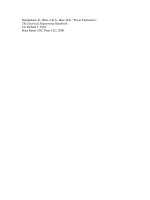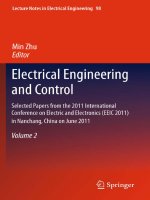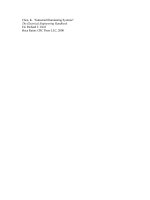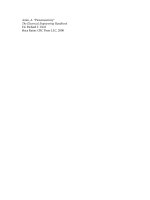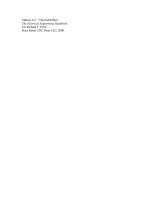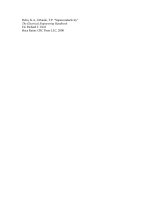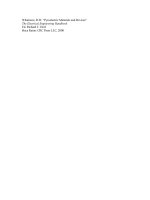Lecture Electrical Engineering: Lecture 9 - Dr. Nasim Zafar
Bạn đang xem bản rút gọn của tài liệu. Xem và tải ngay bản đầy đủ của tài liệu tại đây (822.3 KB, 36 trang )
COMSATS Institute of Information Technology
Virtual campus
Islamabad
Dr. Nasim Zafar
Electronics 1
EEE 231 – BS Electrical Engineering
Fall Semester – 2012
The Diode Circuits:
Lecture No: 9
Contents:
Ø
Introduction.
Ø
The Ideal Diode.
Ø
Dr. Nasim Zafar
2
Terminal Characteristics of Junction Diodes.
References:
Ø Microelectronic Circuits:
Adel S. Sedra and Kenneth C. Smith.
Ø Electronic Devices and Circuit Theory:
Robert Boylestad & Louis Nashelsky ( Prentice Hall )
Ø Electronic Devices :
Thomas L. Floyd ( Prentice Hall )
Dr. Nasim Zafar
3
Introduction:
Ø The simplest and most fundamental nonlinear circuit element is the diode.
Ø Just like a resistor, the diode has two terminals; but unlike the resistor ,
which has a linear (straightline) relationship between the current flowing
through it and the voltage appearing across it, the diode has a nonlinear
iv characteristic.
Ø Let us discuss an ideal diode in order to understand the essence of the
diode function.
Ø We can then study the real silicon pn junction diode and explain its
currentvoltage characteristics.
Dr. Nasim Zafar
4
Introduction:
Applications of the Diode:
Ø One of the important application of a diode is their use in the design of the
rectifiers, which converts an ac signal into a dc signal.
Ø We will also briefly discuss some other specialized diodes such as the
light emitting diodes LED’s and photodiodes.
Dr. Nasim Zafar
5
Diode Equation and Models:
Ø
Ø
In this lecture we will discuss some models for the operation
and design of the diode to explain diode characteristics.
We can use these models instead of the diode equation in
circuit analysis.
Ø
Later on, we will be developing similar models
(or equivalent circuits) to represent the behaviour of
transistors when they are used as linear amplifiers.
Dr. Nasim Zafar
6
Modeling The Diode:
Ø
The Ideal Diode Model
Ø
The Exponential Model
Ø
Load Line Analysis
Ø
PiecewiseLinear Model
The Diode Models
1. The Ideal Diode Model
The Diode:
PN Junction Diode Schematic Symbol:
Anode
Cathode
p
Dr. Nasim Zafar
n
9
Diode Circuits:
anode
Reversed bias
+
+
Forward bias
cathode
The left hand diagram shows the reverse biased junction.
No current flows flows.
The other diagram shows forward biased junction.
A current flows.
Dr. Nasim Zafar
10
Forwardbiased diode Circuit:
R
R
I F > 0A
I F > 0A
IF
V
IF
V
+V
-V
R
R
IF
Dr. Nasim Zafar
IF
11
Reversebiased diode Circuit:
R
R
0A
0A
IT
IT
V
V
+V
-V
R
R
Dr. Nasim Zafar
12
The Ideal Diode Model:
CurrentVoltage Characteristic:
The ideal diode the most fundamental nonlinear circuit element. Useful
for circuits with more than one diode
IF
Forward
operating
region
II
I
VR
VF
III
IV
Reverse
operating
region
IR
Dr. Nasim Zafar
13
IV Characteristics of an Ideal Diode
R
Ø
Ø
0
I
V
R
R
I
V
R
0
If the voltage across anode and cathode is greater than zero, the
resistance of an ideal diode is zero and current becomes infinite.
However, if the voltage is less than zero, the resistance becomes
infinite and current is zero.
Dr. Nasim Zafar
14
Effect of VF.
I
VS
5 V
4.3 V
VD1 = 0.7V
R1
1 k
VR1 = VS − VD1 = 5V − 0.7V = 4.3V
VR1 4.3V
I=
=
= 4.3mA
R1 1kΩ
D1
Value
Ideal
Practical
VF
0 V
0.7 V
VR1
5 V
4.3 V
I
5 mA
4.3 mA
Dr. Nasim Zafar
15
Two Modes of Operation: On or Off
Forward Biased Diode:
Ø
If a positive voltage is applied to an ideal diode, zero voltage
drop appears across the diode and it behaves as a short circuit.
Diodes operated in this mode are called forward biased.
Ø
Current must flow in the forward biased diode. A forward
biased diode is said to be turnedon or simply “on”.
Dr. Nasim Zafar
16
Two Modes of Operation: On or Off
Reverse Biased Diode:
Ø
When a negative voltage is applied to the pside of a diode,
no current flows and the diode behaves as an open circuit.
Diodes operated in this mode are called reverse biased diodes.
Ø
An ideal diode has zero current in the reverse biased mode and
is said to be cutoff or off.
Dr. Nasim Zafar
17
The Ideal Diode Model:
Ø
Consider the two modes of operation for an ideal diode,
either “on” or “off”.
It acts as a switch since:
I
OFF
Ø
Ø
ON
In the ON state it is short circuit.
V
In the OFF state it is open circuit.
Dr. Nasim Zafar
18
Ideal diode characteristics:
Forward bias
Biasing polarities
(+)
Reverse Bias
(-)
(-)
(+)
IF
Equivalent switch
state
ON
OFF
Device resistance
Zero
Infinite
Device current
AtoK current
determined by external
resistance and voltage
Zero
AtoK voltage
Zero
Dr. Nasim Zafar
Equal to the applied
voltage
19
Terminal Characteristics of Junction Diodes
Ø
Ø
The ForwardBias Region, V ≥ 0
The ReversedBias Region, V ≤ 0
CurrentVoltage Characteristic:
Ideal Diode
Real Diode
Ø
Positive voltage yields finite current
Ø
Negative voltage yields zero current
Dr. Nasim Zafar
21
Diode Voltages:
To forward bias a diode,
the anode must be more
positive than the cathode or
LESS NEGATIVE.
To reverse bias a diode,
the anode must be less
positive than the cathode
or MORE NEGATIVE.
A conducting diode has about 0.6 volts across if silicon, 0.3 volts if germanium.
Dr. Nasim Zafar
22
Example 1 Forward Biased:
I
R1
1 k
VS
5 V
D1
Dr. Nasim Zafar
23
Example 2Reverse Biased:
I
R1
1 k
VS
5 V
D1
Dr. Nasim Zafar
24
Diode iv Characteristics: (Ref No. 3)
less than 1mA at 300K
Vknee
Dr. Nasim Zafar
25
